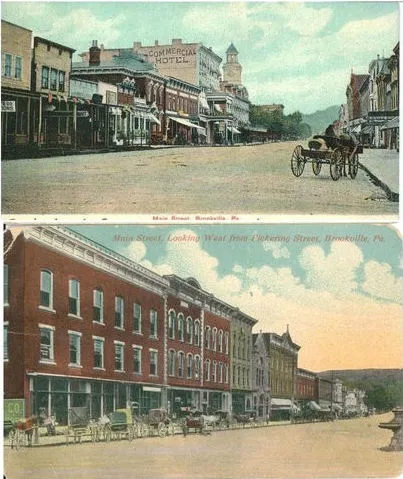Settlement in the Brookville area dates back to 1797 when Joseph Barnett brought his family to the place now called Port Barnett. Several years earlier, Joseph, his brother Andrew, and his wife's brother, Samuel Scott, had arrived and, with the help of nine Native Americans, built a mill.
In 1804, Jefferson County was established from part of Lycoming County. Then the county included much of what we today know as Forest, Elk, and Jefferson Counties. When Moses Knapp built a mill at the confluence of the rivers, he became the first known settler within the present borough limits. Three commissioners appointed by the Legislature designated Brookville the county seat in 1830, and surveyors laid out the town in a grid pattern with most lots measuring 58' by 150'. Lots were sold for $30 to $300, and specific lots were reserved for public buildings and a burial ground.
Brookville's early growth can be attributed to its strategic location along the S& W toll road completed in 1822 from the Susquehanna River in Clearfield County northwest to Waterford in Erie County. The population grew to 276 by 1840, but much of the town was still a wilderness when the Brookville Academy was built at the corner of Jefferson and Barnett Streets.
Settlers arrived at the timber and farm. Two local inventions made growth in the lumber trade possible - the bracket dam system for creating artificial flooding on the shallow river systems and the logging railroad built by Pier and Wright in 1864. Logging railroads made it possible to move logs longer distances to the rivers. Raftsmen constructed large rafts of timber or sawn boards, and the high water seasons in the spring and fall saw them plying the waters between the still small town and the major lumber markets in Pittsburgh. Families whose fortunes were made in lumbering built many fine older homes and commercial buildings you see today.The Low Grade Division of the Allegheny Valley Railroad arrived in 1873 along with coal mining, and prospects soared for industrial and commercial development. Brookville had several diverse industries, most of which faded from the scene as new technologies developed during the late 19th and 20th centuries. These included a ladder factory, two breweries, several hotels, furniture and glass factories, several livery stables, carriage manufacturers, a woolen mill, and foundries. An axe factory produced 250 axes per day, and the Twyford Motor Company, which operated around 1905, made at least six of the world's first 4-wheel drive automobiles.
During the 20th century, timbering, which had waned by about 1900, once again became a significant industry. I-80 crossed the county in the 1960s, and in 1983, Brookville was named a National Historic District, becoming one of Pennsylvania's first Main Street Projects. Many exquisite buildings from more than a century ago have been preserved. We welcome you to Historic Brookville, one of America's Treasures.
